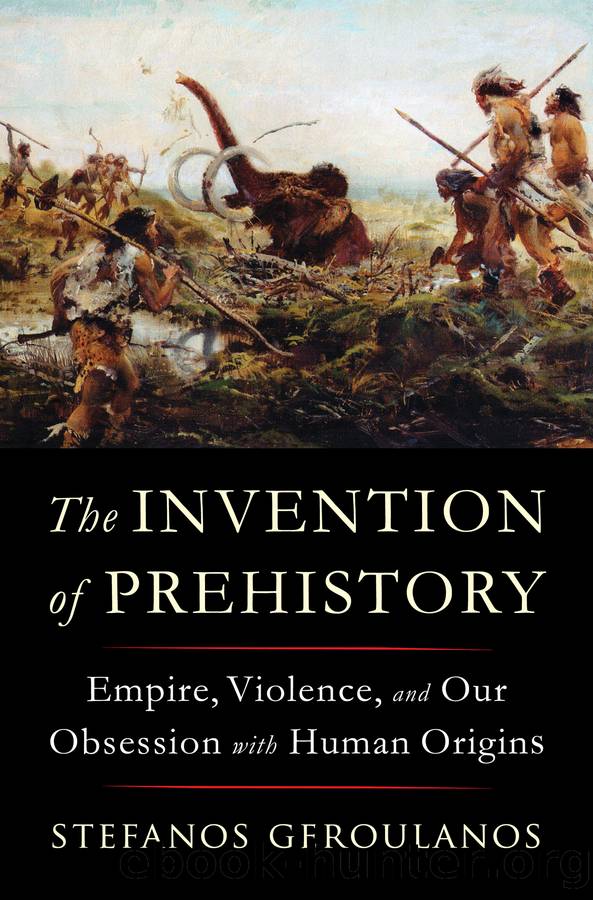The Invention of Prehistory by Stefanos Geroulanos

Author:Stefanos Geroulanos
Language: eng
Format: epub
Publisher: Liveright
Published: 2024-02-25T00:00:00+00:00
Figure 15.1. From Wilfrid Le Gros Clark, The Antecedents of Man (1959): Note the visual contrast between the aboriginal man and the rather genteel chimpanzee who faces him and seems to be the focus of most gazes. Note also the play on gazes: the chimpanzee seems their focus, and we, standing outside the little scene, look in to examine them all.
Western civilization has stationed its soldiers, trading posts, plantations and missionaries throughout the world; directly or indirectly it has intervened in the lives of the coloured peoples; it has caused a revolutionary upheaval in their traditional way of life, either by imposing its own customs, or by creating such conditions as to cause the collapse of the existing native patterns without putting anything else in their place. The subjugated and disorganized peoples have therefore had no choice but to accept the substitute solutions offered them or . . . to seek to imitate Western ways sufficiently to be able to fight them on their own ground.35
Racism had to be understood not on the terms of the first Statement on Race, not on the abstract grounds determined by someone who declared what race is, but as a consequence of the plain destruction of native societies. This argument on social decomposition became the key figure of Lévi-Straussâs work; it also had the peculiar quality of diminishing the effects of specific acts of colonial violence. In his bestselling memoir Tristes tropiques (1955), as in his career through the 1960s, Lévi-Strauss argued for the value of non-Western forms of life.36 Without them, humanity was âin the process of creating a mass civilization, [the same way] as beetroot is grown in the mass.â Instead of safeguarding multiplicity, the West had taken to traveling and tourism. Europeans believed they were creating equality when they were, in fact, destroying complexity and difference. Polynesian islands, he wrote, âhave been smothered in concrete and turned into aircraft carriers solidly anchored in the southern seas . . . the whole of Asia is beginning to look like a dingy suburb . . . shantytowns are spreading across Africa . . . civil and military aircraft blight the primeval innocence of the American or Melanesian forests even before destroying their virginity.â37 UNESCO, by working to convince an educated Western audience, had failed miserably to understand the difference of othersâthat âmen can coexist on condition that they recognize each other as being equally, though differently, human.â38
At the time, Montagu and Klineberg were becoming the public faces of antiracism in America. Lévi-Strauss was trying to outdo them and UNESCO both. Though blunt, he appealed to the same concerns that motivated UNESCO and other public projectsâthe immensely successful exhibition The Family of Man, for instance. First staged at the Museum of Modern Art in New York in 1955, it toured the world with funding from the US Marshall Plan and the Agency for International Development, and it was eventually viewed by some nine million people.39 The exhibit celebrated a purportedly universal human experience bridging
Download
This site does not store any files on its server. We only index and link to content provided by other sites. Please contact the content providers to delete copyright contents if any and email us, we'll remove relevant links or contents immediately.
The Daily Stoic by Holiday Ryan & Hanselman Stephen(2732)
The Fate of Rome: Climate, Disease, and the End of an Empire (The Princeton History of the Ancient World) by Kyle Harper(2464)
People of the Earth: An Introduction to World Prehistory by Dr. Brian Fagan & Nadia Durrani(2367)
Ancient Worlds by Michael Scott(2139)
Babylon's Ark by Lawrence Anthony(2094)
Foreign Devils on the Silk Road: The Search for the Lost Treasures of Central Asia by Peter Hopkirk(2077)
India's Ancient Past by R.S. Sharma(2006)
MOSES THE EGYPTIAN by Jan Assmann(1994)
The Complete Dead Sea Scrolls in English (7th Edition) (Penguin Classics) by Geza Vermes(1867)
Lost Technologies of Ancient Egypt by Christopher Dunn(1818)
The Daily Stoic by Ryan Holiday & Stephen Hanselman(1817)
The Earth Chronicles Handbook by Zecharia Sitchin(1773)
24 Hours in Ancient Rome by Philip Matyszak(1706)
Alexander the Great by Philip Freeman(1680)
Aztec by Gary Jennings(1572)
The Nine Waves of Creation by Carl Johan Calleman(1536)
Curse Tablets and Binding Spells from the Ancient World by Gager John G.;(1530)
Before Atlantis by Frank Joseph(1502)
Earthmare: The Lost Book of Wars by Cergat(1485)
